While most of people's attention in Brazil was turned to the tragic floods in Santa Catarina, another environmental disaster struck the country, this time in the state of Rio de Janeiro. On November 18, a leak of deadly endosulfan pesticide into the Pirapetinga river, a tributary of Paraíba do Sul River, killed thousands of fish – over 80 tonnes – in Resende and other neighbouring cities. The incident also caused the interruption of the water supply for 7 cities in the area. The tragedy was worsened by the fact that it happened during breeding season for many species, some of which are under threat of extinction. Cintia Sibucs [pt] says that apart from fish, she was sad to see also dead water hogs and even birds:
Pela quantidade de peixes e animais mortos, pode-se dizer que será necessário uns dez anos ou mais para que toda essa vida volte ao que era antes. O produto químico Endosulfan, usado na fabricação de inseticidas, é usado pela empresa que fica em Resende. O acidente gerou ainda mais transtornos pois o serviço de água e esgoto suspendeu a captação de água por uns dias, deixando a população em alerta.
Agora, depois de tanta tristeza de ver milhares de peixes e capivaras mortas, o que resta é recolher o que restou. Desde sábado (22/11) as prefeituras de Volta Redonda e Barra Mansa estão num trabalho ininterrupto de recolhimento dos peixes, que já estava causando forte mau cheiro.
Now, after so much sadness at seeing thousands of dead fish and water hogs, what we are left to do is clean up what remains. Since Saturday (22/11) Volta Redonda and Barra Mansa municipalities have been working non-stop to clean up the dead fish, which have already started to smell strongly.

A dead water hog, photo by Environmental Engineering teacher Ricardo Terra, from Blog do Roberto Morais
The leak was discovered after an investigation led by Rio de Janeiro's Environmental Control Body, alerted by mass deaths of fish in the Pirapetinga and Paraiba do Sul rivers. Resende based Servatis, the company responsible for the fertilizer plant, confessed to the leak of 1.5 thousand litres of endosulfan and alleged it was caused by a human failure when connecting a tanker lorry [pt]. In a post titled “Besides death, no risks”, Vitor Menezes [pt] challenges the company's statement of November 19, barely a day after the accident, claming that the situation was under control:
A empresa Servatis, responsável pelo vazamento do pesticida endosulfan no rio Paraíba do Sul, afirmou aqui em seu site que, de acordo com a sua gerência de meio ambiente, a concentração do produto no rio havia caído a zero e não havia “mais risco à fauna”. Os peixes do post abaixo não devem ter recebido o recado.
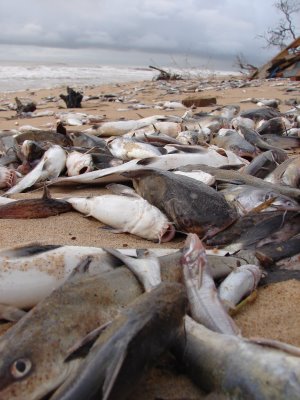
Dead fish, by Environmental Engineering teacher Ricardo Terra, from Blog do Roberto Morais
As discovered later, the leak of insecticide endosulfan was higher than the 1.5 thousand liters stated by Servatis. The product was spilled during the unloading of a 30 thousand liter capacity truck, but only 12 thousand liters, mixed with rain water, were recovered by the company's dike container. Servatis later admitted that at least 8 thousand liters may have leaked – contrary to what it had disclosed in the previous week. Lawyer and environmentalist Luiz Felipe Muniz de Souza [pt] comments on the consequences of the leak to local communities:
Várias comunidades pesqueiras afetadas estão impedidas de trabalhar e nem sabem ao certo quando poderão retornar, pois a ação do inseticida, mesmo tão distante do ponto em que foi despejado pelos criminosos, e mesmo estando tão diluído – devido ao volume do próprio Rio Paraíba do Sul e devido ao volume d’água das intensas chuvas regionais –, continua provocando mortandade de peixes em toda a foz do Paraíba do Sul, e nas praias do município de São João da Barra e de São Francisco do Itabapoana. Os criminosos ambientais, que inicialmente se omitiram e mentiram sobre a quantidade do produto arremessado no rio, depois admitiram que foi uma quantidade 10 vezes maior do que a declarada, diante de tantos peixes mortos!
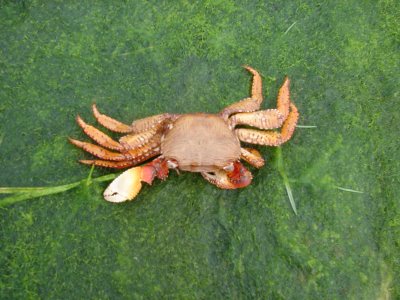
Photo from Blog do Roberto Morais
Servatis received a R$ 33 million fine (about US$ 13.3 million), which will be disputed by the company [pt], and a 20 day suspension penalty. It has resumed operations today, December 9th, in all departments apart from endosulfan production. [pt] reacts to the news:
Mais uma vez o poder público zomba de nós! Sem que nada tenha sido feito para minimizar os danos ao Rio Paraíba a empresa “Servatis volta a operar nesta terça-feira” (…) Em menos de um mês, desde o acidente ambiental, a auditoria realizada por empresa privada solicitada pela SEA foi rapidamente concluída, e sem que houvesse tempo hábil para a realização de uma segunda auditoria ou para que se analisasse a fundo o conteúdo do documento – medidas que poderiam dar mais garantias sobre os processos e ajustes da empresa para a segurança da população – a Servatis abre!
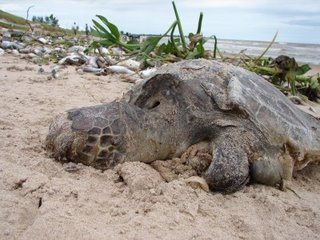
A dead tortoise, from Blog do Roberto Morais
A TroLhA [pt] blog expresses the feelings that environmental law in Brazil is two faced:
O aparato de fiscalização ambiental quando se trata da persecução das medidas de controle e defeso de espécies (alías, necessárias), tem se mostrado eficiente em coibir as infrações cometidas por pescadores e populações que dependem dessa atividade, e que geralmente, ocupam os andares mais baixos da nossa pirâmide social… Por outro lado, quando se trata de estender essa eficiência aos empresários e industriais, que exploram atividades econômicas que trazem sérios riscos ao ecossistema no qual estão inseridos, nossos órgãos ambientais são de uma leniência e ineficácia vergonhosa… Direito a propriedade e a livre iniciativa não podem se sobrepor ao direito a vida…Bom, pelo menos não deveriam…
Rui Camejo [pt] reminds us that it is not the first time that Servatis has harmed the environment. According to the blogger, about three years ago the very same company was also responsible for the leak of Dimetutato insecticide. Fellow blogger :
E essa denúncia não deve se limitar a essa fronteira, à foz desse afluente: deve ser estendida a toda a bacia hidrográfica desse que é, seguramente, um dos mais importantes rios do Brasil, dada a sua relevância nos aspectos sociais e econômicos de toda a região que ela tão generosamente abraça.
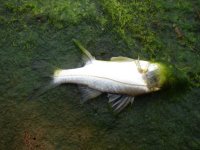

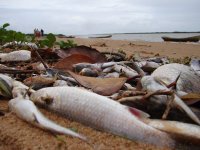

Photos from Blog do Roberto Morais
Paraiba do Sul river, sourced by the junction of Paraibuna and Paraitinga rivers, starts in the Serra da Bocaina, in the state of São Paulo running for 1.12 km to the mouth in Atafona, in the north of Rio de Janeiro State. The Paraiba do Sul river basin extends to three states – São Paulo, Minas Gerais and Rio de Janeiro – and is considered, in area, one of three major river basins in Brazil, covering an approximate area of 57,000km².
Banned in many countries wordwilde, endosulfan is widely used in the control of a large variety of insects and mites in crops. Its use is banned in Europe and the Environmental Justice Foundation is running a campaign for people to press their national governments to ban endosulfan and list this chemical on the Stockholm Convention.
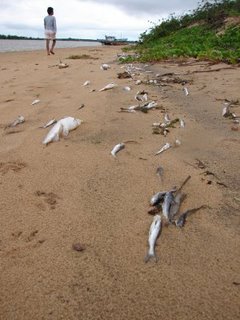
Photo from Blog do Roberto Morais







6 comments
This story and the pictures of the dead animals are very disturbing. I have been reading about the disappearance of species due to global warming and environmental degradation, and this is yet another gut wrenching example of our careless treatment of the earth. My heart goes out to the people who’s lives depend on this river.
Thanks for showing sympathy Mat. I hope that by spreading this images, even if disturbing, we can help to raise awareness of issues like this and make sure that we follow up and see that culprits are punished.
I deeply regret the loss of invaluable marine life as a result of this tragic accident. Contaminated water and soil can quickly be treated chemically and with useful microbes to degrade Endosulfan residues.
Environmental criminals!! Exactly! Making a mess, destroying lives, and not taking responsibility for it. Remember what Chevron did in Ecuador? They dumped over 18 billion gallons of oil and toxic water into the streams. Today the drinking water is contaminated and over 1,000 people have died from cancer and thousands more are sick with skin disease and respiratory illness and Chevron still does not want to admit they did something wrong.
If you want to find out more about what is surely the largest environmental disaster on the planet, read this blog, http://www.thechevronpit.blogspot.com and this article, http://www.http://latimesblogs.latimes.com/laplaza/2008/11/ecuador-keeps-u.html
In my opinion I believe the reason this crisis happen was because of the standard and the procedure that was regulated by the company. They should have stricter rules and standard while processing with the chemical. As a result it would benefit everyone including the company themselves, as there would no loss of money and resources but a gain. This wouldn’t have happen if these safety regulation were pass out.
Think about the mistake that was made. With just one small mistake, it could lead into such a big issues that affects everyone. I feel sympathy for the people who earned a living by using the resources from that river. Since the river is a sources of food. But as the animals and it’s habitat are being wiped out by the toxic waist, it would be impossible to get food as well as water supplies. I thought to myself, what will they do now? Will it affect their lives since the rivers is like a part of their daily life. I also thought about the people drinking that water, what if there are still traces of the chemical?
So if the little mistakes were never made all of this mess wouldn’t be occurring like a chain reaction. In other word it is better to not start it at all.